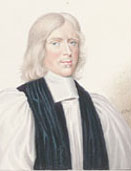William Lloyd (bishop of Worcester) facts for kids
Quick facts for kids The Right Reverend William Lloyd |
|
|---|---|
| Bishop of St Asaph, Lichfield and Coventry and Worcester | |
 |
|
| Enthroned | 1689 |
| Personal details | |
| Born | 18 August 1627 Tilehurst, Berkshire |
| Died | 30 August 1717 (aged 90) Hartlebury Castle, Worcestershire |
| Buried | church of Fladbury, near Kvesham, Worcestershire |
| Denomination | Church of England |
| Parents | father Richard Lloyd, grandfather David Lloyd of Henblas, Anglesey. |
| Children | at least one son |
| Alma mater | Oriel and Jesus Colleges, Oxford |
William Lloyd (born August 18, 1627 – died August 30, 1717) was an English church leader. He served as a bishop in three different areas: St Asaph, Lichfield and Coventry, and Worcester.
Contents
Who Was William Lloyd?
Early Life and Education
William Lloyd was born in 1627 in Tilehurst, Berkshire. His father, Richard Lloyd, was a local church leader. William showed great promise from a young age. By the time he was eleven, he already understood Greek, Latin, and some Hebrew.
He went on to study at Oriel and Jesus Colleges at the University of Oxford. He became a Fellow at Jesus College, which meant he was a senior member of the college. In 1646, he earned his Master of Arts degree.
His Journey as a Church Leader
William Lloyd had a long and important career in the Church of England. He held many different positions over the years. In 1663, he became a prebendary of Ripon. This is a type of church official.
He then served as a prebendary of Salisbury in 1667. In 1668, he became an archdeacon in Merioneth. An archdeacon helps the bishop manage the church's affairs. By 1672, he was the dean of Bangor Cathedral and a prebendary of St Paul's in London.
In 1680, William Lloyd became a bishop for the first time, serving in St Asaph. He later became the lord-almoner in 1689. This role involved distributing money to the poor on behalf of the king. He then became Bishop of Lichfield and Coventry in 1692. As Bishop of Lichfield, he helped rebuild Eccleshall Castle, which was a home for bishops that had been destroyed during the Civil War. In 1699, he became the Bishop of Worcester.
Standing Up to the King
William Lloyd was known for being very brave. He strongly disagreed with King James II's ideas about the Roman Catholic church. The King wanted to make a rule called the Declaration of Indulgence. This rule would have allowed more religious freedom, but many people, including Lloyd, felt it gave too much power to the King and went against the Church of England.
Lloyd was one of seven bishops who refused to read this declaration in their churches. Because of this, they were accused of writing a "seditious libel" against the king. This meant they were charged with trying to cause trouble against the government. However, in 1688, William Lloyd and the other bishops were found not guilty. This event was a big deal and helped lead to King James II losing his throne.
Supporting Change and New Ideas
William Lloyd was a strong supporter of the Glorious Revolution. This was a time when King James II was replaced by William and Mary. Lloyd believed in the changes that came with this new leadership.
He was also a very smart scholar. He helped Gilbert Burnet write a famous book called The History of the Reformation of the Church of England. Lloyd gave Burnet a lot of information for the book. He was also very interested in old religious writings and even made predictions to important people like Queen Anne.
Later Years and Legacy
William Lloyd lived a very long life, reaching the age of ninety-one. He passed away at Hartlebury Castle on August 30, 1717. He was buried in the church of Fladbury, near Evesham in Worcestershire. His son was a church leader in that area. A special monument was put up in the church to remember him.
What Did William Lloyd Write?
William Lloyd wrote several important works during his lifetime.
- His main book was An Historical Account of Church Government as it was in Great Britain and Ireland. This book, published in 1684, talked about how the church was organized in Britain and Ireland when Christianity first arrived.
- He also helped update a famous timeline of history by Ussher for a special edition of the King James Bible in 1701. This Bible was published under the guidance of Archbishop Tenison.

